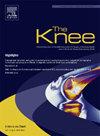在内侧闭合楔形股骨远端内翻截骨术中进行冠状截骨时应考虑的股骨远端内侧表面形态学。
IF 1.6
4区 医学
Q3 ORTHOPEDICS
引用次数: 0
摘要
目的:本研究的目的是利用普通CT评价在内侧闭合楔形股骨远端内翻截骨术(MCWDFO)冠状截骨术中股骨远端内侧面形态。方法:纳入20例膝关节,平均年龄55.3岁。外翻性骨关节炎的术前CT图像是在MCWDFO之前获得的。在横切起始位置的横切面上,绘制一条穿过股皮质中心的曲线,并绘制平行和垂直于手术上髁轴(SEA)的线来分析内侧。内线上的拐点定义为P1-P4。绘制通过P1-P3 (PR,桡骨后缘)和P2-P4 (AR,桡骨前缘)的圆半径。测量PR、AR和半径比(PR/AR)值。结果:根据PR/AR,将横切面形态分为5种三角形型(PR/AR < 0.5)、4种扁平型(PR/AR > 0.8)和11种凸型(PR/AR 0.6 ~ 0.7)。结论:平型内前后位宽度和翼缘厚度较易评估;然而,在前倾较缓的三角型中,这些很难评估。在进行MCWDFO冠状面截骨术时,外科医生应根据横截形态考虑前斜坡的差异。本文章由计算机程序翻译,如有差异,请以英文原文为准。
A morphology of the distal medial femoral surface that should be considered when performing coronal osteotomy in medial closed wedge distal femoral varus osteotomy
Aims
The aim of the present study was to evaluate the morphology of the distal medial femoral surface during coronal osteotomy in medial closed wedge distal femoral varus osteotomy (MCWDFO) using plain CT.
Methods
Twenty knees (mean age, 55.3 years) were included. Preoperative CT images were obtained prior to MCWDFO for valgus OA. In the cross-section depicting the starting position of the transverse cut, a curve was drawn that passed through the centre of the femoral cortex, and lines parallel and perpendicular to the surgical epicondylar axis (SEA) were drawn to analyse the medial side. Inflection points on the medial line were defined as P1-P4. The radii of circles passing through P1-P3 (PR, posterior radius) and P2-P4 (AR, anterior radius) were drawn. Values for the PR, AR, and radius ratio (PR/AR) were measured.
Results
Based on the PR/AR, the cross-sectional morphologies were classified into 5 triangular types (PR/AR < 0.5), 4 flat types (PR/AR > 0.8), and 11 convex types (PR/AR 0.6 to 0.7).
Conclusion
The medial anteroposterior width and flange thickness were easier to assess in the flat type; however, these were difficult to assess in the triangular type with a gentle anterior slope. Surgeons should consider the differences in the anterior slope according to cross-sectional morphologies when performing coronal osteotomy in MCWDFO.
求助全文
通过发布文献求助,成功后即可免费获取论文全文。
去求助
来源期刊

Knee
医学-外科
CiteScore
3.80
自引率
5.30%
发文量
171
审稿时长
6 months
期刊介绍:
The Knee is an international journal publishing studies on the clinical treatment and fundamental biomechanical characteristics of this joint. The aim of the journal is to provide a vehicle relevant to surgeons, biomedical engineers, imaging specialists, materials scientists, rehabilitation personnel and all those with an interest in the knee.
The topics covered include, but are not limited to:
• Anatomy, physiology, morphology and biochemistry;
• Biomechanical studies;
• Advances in the development of prosthetic, orthotic and augmentation devices;
• Imaging and diagnostic techniques;
• Pathology;
• Trauma;
• Surgery;
• Rehabilitation.
 求助内容:
求助内容: 应助结果提醒方式:
应助结果提醒方式:


